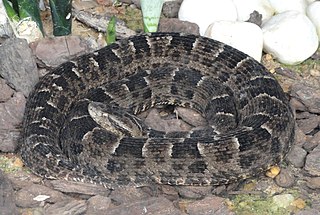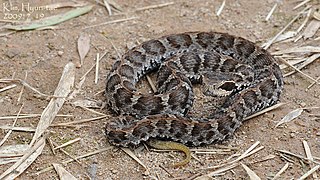
Bothrops atrox — also known as the common lancehead, fer-de-lance, barba amarilla and mapepire balsain — is a highly venomous pit viper species found in the tropical lowlands of northern South America east of the Andes, as well as the Caribbean island of Trinidad. No subspecies are currently recognized.

Bothrops is a genus of highly venomous pit vipers endemic to the Neotropics. The generic name, Bothrops, is derived from the Greek words βόθρος, bothros, meaning "pit", and ώπς, ops, meaning "eye" or "face", together an allusion to the heat-sensitive loreal pit organs. Members of this genus are responsible for more human deaths in the Americas than any other group of venomous snakes. Currently, 48 species are recognized.

Bothrops alternatus is a highly venomous pit viper species found in South America. Within its range, it is an important cause of snakebite. The specific name, alternatus, which is Latin for "alternating", is apparently a reference to the staggered markings along the body. No subspecies are currently recognized.

Bothrops jararaca—known as the jararaca or yarara—is a highly venomous pit viper species endemic to South America in southern Brazil, Paraguay, and northern Argentina. The specific name, jararaca, is derived from the Tupi words yarará and ca, which mean 'large snake'. Within its geographic range, it is often abundant and is an important cause of snakebite. No subspecies are currently recognized.

Bothriechis aurifer is a venomous pit viper species found in Mexico and Guatemala. No subspecies are currently recognized.

Bothrops taeniatus, the speckled forest-pitviper, is a species of pit viper found in the equatorial forests of South America endemic to Colombia, Ecuador, Peru, And Brazil. The specific name, taenia, is derived from the Greek word, tainia, meaning ribbon bandage or stripe, in reference to the slender body. Two subspecies are currently recognized, including the nominate subspecies described here.

Bothrops neuwiedi is a highly venomous pit viper species endemic to South America. This relatively small snake has a wide range and is a major source of snakebite in Argentina. It was named after German naturalist Prince Maximilian of Wied-Neuwied (1782-1867), who made important collections in Brazil (1815-1817). Seven subspecies are currently recognized, including the nominate subspecies described here.

Bothrops bilineatus, also known as the two-striped forest-pitviper, parrotsnake, Amazonian palm viper, or green jararaca, is a highly venomous pit viper species found in the Amazon region of South America. Two subspecies are currently recognized, including the nominate subspecies described here. A pale green arboreal species that may reach 1 m (3.3 ft) in length, it is an important cause of snakebite throughout the entire Amazon region.
Gloydius strauchi is a species of venomous pit viper in the subfamily Crotalinae of the family Viperidae. The species is native to western China. It is a small snake with a pattern of four longitudinal stripes, although some older specimens may be a uniform black. G. strauchi may be distinguished from G. monticola by its higher midbody dorsal scale count. This species jointly holds the altitude record for pitvipers together with Crotalus triseriatus of Mexico, both being found even above the tree line at over 4,000 m (13,000 ft). No subspecies were recognized as being valid, until a recent publication re-evaluated the taxonomic statuses of populations of G. strauchi and described the eastern Tibetan populations as a new species.

Gloydius ussuriensis is a venomous pitviper species endemic to far east Russia, northeastern China and the Korean Peninsula. No subspecies are currently recognized.

Gloydius brevicauda is a venomous pitviper species endemic to China and the Korean Peninsula.
Bothrops medusa is a venomous pitviper species endemic to Venezuela. No subspecies are currently recognized.

Bothrops oligolepis is a venomous pitviper species found in Peru and Bolivia. The specific name is derived from the Greek words oligo and lepis, meaning "few scales"; probably an allusion to the lower numbers of dorsal and ventral scales that it has compared to B. bilineatus. No subspecies are currently recognized.
Bothrops pulcher is a venomous pitviper species found in South America. The specific name is Latin, meaning "beautiful", in reference to the color pattern. No subspecies are currently recognized.

Bothrops punctatus is a venomous pitviper species found in Ecuador, Mostly in the Chocó Department in Western Colombia and Panama. No subspecies are currently recognized.

Bothrops bilineatus smaragdinus is a venomous pitviper subspecies found in the northern and western Amazon region of South America.
Bothrocophias andianus is a venomous pit viper species endemic to the Andes in South America. No subspecies are currently recognized.
Bothrocophias campbelli, commonly known as Campbell's toadheaded viper, the Ecuadorian toadheaded pitviper, and víbora boca de sapo in Spanish, is a species of venomous pitviper in the family Viperidae. The species is endemic to South America. No subspecies are currently recognized.

Bothrops fonsecai, also known commonly as Fonseca's lancehead, is a species of venomous snake in the family Viperidae. The species is endemic to Brazil.

Bothrops moojeni, commonly known in English as the Brazilian lancehead, is a species of venomous snake in the family Viperidae. It is a pit viper endemic to South America.
















